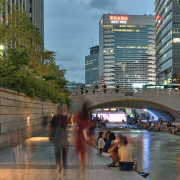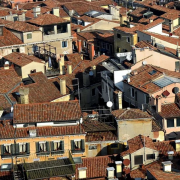Cities & Covid-19 | Tel Aviv-Jaffa, Israel by Romy Chillag
Students & researchers share their impressions of urban living during a pandemic | a TAU City Center special project
The importance of urban nature a hundred meters from home
Are you also exploring in the last months what is in the proximity of your home? Do you also feel the need for open and green spaces?
On May 17, 2020 new measurements by the Israeli Ministry of Health have set out, according to the corona virus guidelines. The measurements determined that going to parks, beaches and public spaces is forbidden. These public spaces became inaccessible to the public, even if social distancing was carried out, while other spaces were allowed. This caused distress and confusion among the public.
However, it is interesting to know that during the cholera epidemic, it was decided that there was a need to establish more parks in London, to heal the public (Thompson, 2011).

Urban nature in Tel Aviv-Jaffa. Image by Romy Chillag
In this article, I will review several historical and current anecdotes about public health and the importance of accessibility to parks.
Many studies have explored how leaving the house and spending time in a natural environment contributes greatly to mental and physical health, for people of all ages. Researcher Catherine Ward Thompson, a landscape architect, explores the connection between human health and residential proximity to nature and parks. In her article "Linking landscape and health: The recurring theme", she reviews the positive effects living near parks and green areas in cities has on health: an influence researchers has named “Vitamin G” (Green).
In the city of Tokyo, a dense metropolitan city with about 14 million inhabitants, dense urban areas were examined. Researchers have found a direct link between an increase in the survival rate and the life expectancy of elderly citizens and their access to a green environment, parks, and trees.
In many other cities that have been examined, studies have shown that there is a direct correlation between the decline in stress and anxiety levels of residents, decrease in morbidity and increase in life expectancy, and the proximity of the residential space to natural green areas (Thompson, 2011). Apart from the decline in stress levels that are typical for a life in a busy and crowded city, additional benefits were found, such as an increase in attention and concentration levels as a result of more frequent visits to parks.
In addition to the benefits it offers people, urban nature environments also provide system-support services such as: balancing climate change effects, providing wildlife habitat and preservation of biodiversity (Baur et al., 2013)
Epidemics, health and the importance of parks
The idea of accessibility to public parks within the city started at the end of the industrial revolution. The main goal was to maintain the health of the urban population that rapidly grew in Europe's most polluted cities. Therefore, the principle of accessibility was important so all population strata will be able to breathe fresh air, recover and vacate.
.jpeg)
Urban nature in Tel Aviv-Jaffa. Image by Romy Chillag
Epidemics hold an important part in establishing and developing parks. During the first Cholera epidemic of England in 1832, the elected committee for public trips, has announced to the British parliament the need to create spaces of leisure and recreation.
Therefore, it has been urged to enact a law requiring to allocate space in each city for a stroll or a park to improve the health conditions in the country.
The establishment of Victoria Park in east London
Victoria Park in London was established in the east of the city in an industrial, polluted and crowded. These neighborhoods were built between many pollutants. In 1830, some 400,000 residents lived in this area and worked as factory workers. But the living conditions did not allow for a healthy life, because the air, the water and the streams were polluted.
Fear of diseases, such as Cholera, Typhus and Tuberculosis, grew among the rich population. They were concerned the viruses may come from these polluted and crowded areas and will scatter the rich and clean parts of London. It was thus decided to build a park in the east of the city, that would contribute to reducing the number of deaths and adding a few years to the life of the population that lives in these neighborhoods, thereby promote the economy. "The park is designed to benefit the health of the employees and their families by inhaling fresh air at least Once a week it is very important" (Alston, 1847). Another quote that illustrates the importance of creating the parks during this period is: "The pale mechanic and the exhausted factory operative might inhale the freshening breeze and some portion of recovered health" (Smith, 1852, in Schuyler, 1986, p. 60).
Conclusion
We are at a time where a mere stroll in the park raises concerns and might be not accessible to all the population. Considering the studies above, perhaps focusing on making our natural urban sources can contribute to our health. Especially in an epidemic in which an elderly and sick population should breathe clean air, rejuvenate and heal. Perhaps at a stressful and uncertain time like this, we should especially take care of maintaining our health and our mental health by spending time in nature. In order to recover from the stress, we must experience quality nature, especially in the months of spring, when the flowers bloom and nature is rejuvenating.
As many of us has experienced a difficulty finding green areas around our homes, a central oconclusion from this epidemic is the need for planning better cities. Cities which integrate nature and quality public spaces. Places where you can find peace and tranquility from the busy life, to be present in the magic of nature, to relax and heal. I call the decision makers in Israel, embrace the 19th-century London approach and make sure that the public spaces planned will be open and accessible. These spaces can support both man and nature.
.jpeg)
Urban nature in Tel Aviv-Jaffa. Image by Romy Chillag
Bibliography
Baur, J. W. R., Gómez, E., & Tynon, J. F. (2013). Urban Nature Parks and Neighborhood Social Health in Portland, Oregon. Journal of Park & Recreation Administration, 31(4), 23–44.
Thompson, C. W. (2011). Linking landscape and health: The recurring theme. Landscape and urban planning, 99(3-4), 187-195.
Schuyler, D., 1986. The New Urban Landscape: The Redefinition of City Form in Nineteenth-Century America. John Hopkins University Press, Baltimore.
_________________________________________________
Romy Chillag, founder of Romy Urban Nature Tours. A Master’s student for urban planning in Tel Aviv University, researching urban nature, works in the Ministry of Environmental Protection and professional tour instructor in the city and Nature.
*Text and images by Romy Chillag





